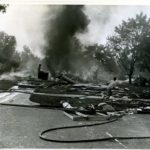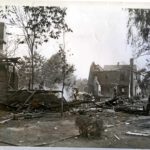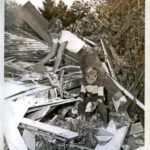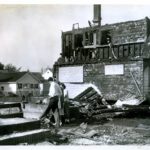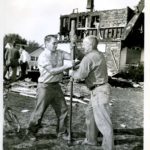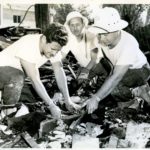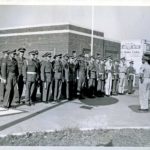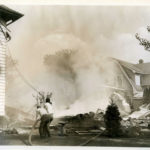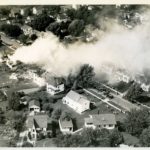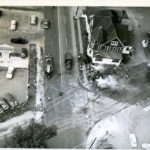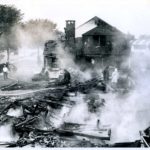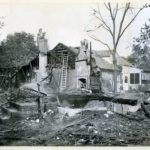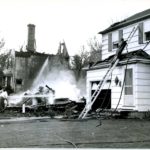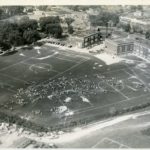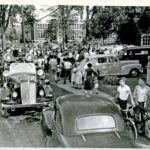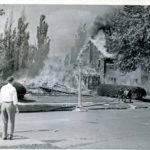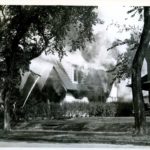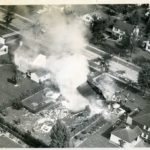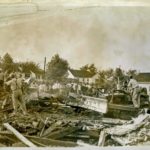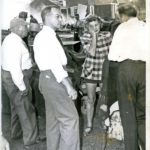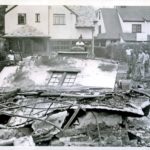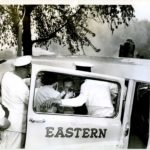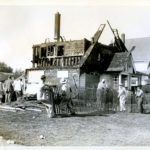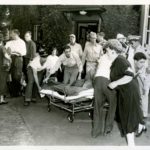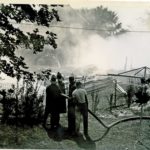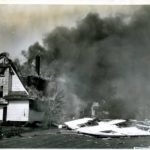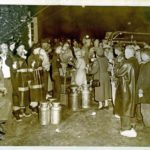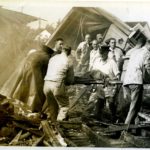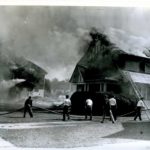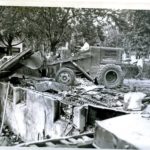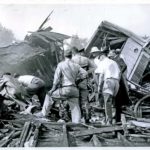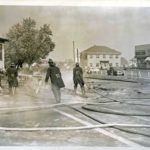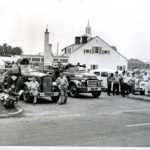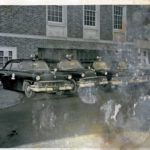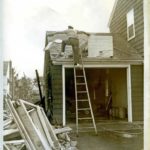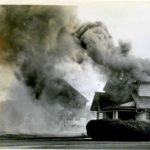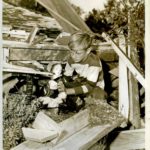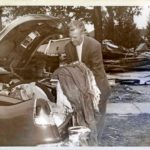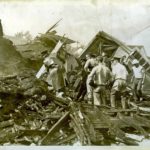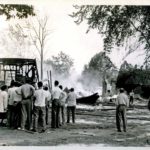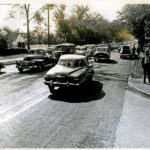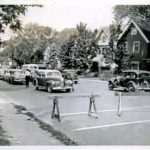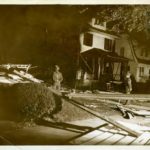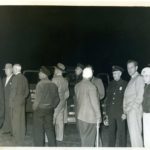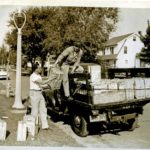On September 21, 1951, sometimes called “Black Friday,” the lives of two Meadowbrook children were lost in the “Brighton Blast”. Eight-year-old Mary Anne Maas and her five-year-old brother William died when their Buckland Avenue home exploded on that quiet Friday afternoon. Fifteen homes were completely destroyed, sixteen others were seriously damaged, and twenty-three were damaged by fire or flying debris in the neighborhoods surrounding Twelve Corners.
Jump to Black Friday photo gallery…
Jump to Black Friday investigation report…
An underground vault located at Twelve Corners housed natural gas regulators. No one was working in the vault at the time, although nearby there were men repairing a section of sidewalk outside the Chateau Restaurant, at Winton Road and Monroe Avenue. The men repairing the sidewalk had completed their work, lighted flares for the night and were leaving the job when the vault exploded. It was believed that the flares touched off a gas leak within the nearby vault. A manhole cover on the vault was blown into the air. As it fell, it struck the regulator mechanism forcing it into an “open” position, which sent excessive gas pressure into homes in the immediate area.
The gas reached the homes with such high pressure that it caused pilot lights on stoves to shoot eight inches into the air. For people who were home, this was an alarming indication that something was very wrong. Others felt the furnace go on and became puzzled since it was a warm, sunny day. Except for a sudden, intense hiss of gas, there was no warning of the series of explosions that destroyed homes, started fires, killed three, and injured at least 38 people in the neighborhoods of Roselawn, Bel Air and Meadowbrook. Homes exploded on Sylvan Road, Antlers Drive, Meredith Street, Fair Oaks Avenue and Seneca Drive in the Roselawn section. There were explosions at homes on Oakdale Drive, Glen Ellen Way, Varinna Drive and Mayflower Drive in the Bel Air neighborhood. In Meadowbrook, two houses on Bonnie Brae Avenue and one on Buckland Avenue were leveled. Mrs. Louis A. Meyer, of 41 Antlers Drive, who was seventy-seven-years-old, died of a heart attack as she and her daughter tried to escape the devastation walking to Twelve Corners.
Rochester’s Democrat and Chronicle newspaper accounts of the catastrophe describe the neighbors’ immediate reactions as shock, fear, and utter confusion. Initially, no one knew why the houses around them were randomly exploding. It soon became apparent that the gas valves should be turned off and several heroic neighbors risked danger entering as many homes as they could, running to the basement with a wrench in hand.
An aerial photograph taken about a half hour after the first explosion in Meadowbrook shows six houses aflame, sending up heavy clouds of smoke that darkened the sky. Local hotels filled with people whose homes were damaged or destroyed. Most residents left the area until they felt secure in returning later that weekend. Neighbors, such as David Leavitt, remember standing guard on the night watch at the roadblock at the corner of Avalon Drive and Winton Road. Meadowbrook residents teamed up with Civil Defense disaster crewmen and the National Guard to spray water hoses and shovel rubble, and to prevent vandals from entering abandoned houses. State police, local police and volunteers from all over Monroe County and beyond were called upon for their assistance. The Red Cross sent workers to help with emergencies at Twelve Corners where a tent was erected to administer first aid for burns, cuts, and smoke inhalation. At the Brighton Town Hall, members of the American Legion helped distribute food and supplies donated by area businesses, restaurants, and bakeries, to feed the workers and victims of the disaster. Ministers, Priests and Rabbis roamed through the district offering consolation and aid to families driven from their homes.
Unauthorized traffic was barred in Brighton in an attempt to prevent on-lookers from entering the area. Roadblocks were set up at the intersection of Monroe Avenue and Culver Road; drivers were warned to stay away. Regardless, cars lined the surrounding streets trying to get a glimpse of the devastation, merely causing dangerous traffic congestion.
Late the next day, loudspeaker trucks announced that people could return to their homes. RG&E instructed the owners of 1,400 houses in the blast zone comprising the section bounded by Highland Avenue, Winton Road, Avalon Drive and Westland Avenue to leave the gas off until further notice and to open all doors and windows. No additional fires were reported.
Alexander M. Beebee, the president of Rochester Gas and Electric, expressed his company’s ” deepest sympathy for the bereavement, suffering, sorrow and inconvenience that has been brought to some of our customers by this unfortunate accident.” Though, sadly, three lives were lost, there was also a “miracle of timing” that occurred. Friday afternoon was traditionally a shopping day for many housewives and, because it was a pleasant day, many people were outdoors. With men at work and most children at school during the daytime, not many people were in their homes. No one wanted to think about what would have happened had the catastrophe occurred at nighttime or even the next day.
Each person who lived through this tragedy has their own story to tell. For every account of injury, fear and horror there seems to be a story of a narrow escape or of an act of heroism.
Black Friday Photos
What follows is a photo collection that was gathered by then-Brighton Police Chief Vincent Conklin. Note that these photos capture the devastation and chaos all around the 12 Corners area.
Black Friday Investigation Report
The report that follows was created for the Town of Brighton by the National Board of Fire Underwriters and the New York Fire Insurance Rating Organization.
Investigation-Report
